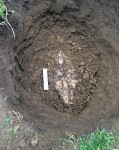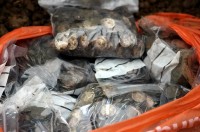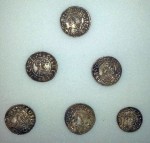 Barely did the year turn before news broke of a new hoard of coins unearthed by metal detectorists in an English field. The finder, Paul Coleman, was scanning farmland near Aylesbury, Buckinghamshire, as part of the Weekend Wanderers Detecting Club‘s yearly Christmas rally when he discovered a piece of lead and a silver coin. When he moved a larger fragment of lead, he saw there were rows of coins underneath. Buckinghamshire Finds Liaison Officer Ros Tyrrell was on site in case something notable was found, so she was able to coordinate a proper excavation after the first few coins were exposed.
Barely did the year turn before news broke of a new hoard of coins unearthed by metal detectorists in an English field. The finder, Paul Coleman, was scanning farmland near Aylesbury, Buckinghamshire, as part of the Weekend Wanderers Detecting Club‘s yearly Christmas rally when he discovered a piece of lead and a silver coin. When he moved a larger fragment of lead, he saw there were rows of coins underneath. Buckinghamshire Finds Liaison Officer Ros Tyrrell was on site in case something notable was found, so she was able to coordinate a proper excavation after the first few coins were exposed.
The area was cordoned off and before an increasingly large crowd of detectorists (there were more than 100 club members at the rally) the find carefully excavated. Silver coins filled a large lead container, apparently a bucket that was folded over at the top to cover the hoard, buried about two feet underground. Portraits on some of the coins identified them as having been minted during the reigns of Ethelred the Unready (reigned 978-1013, 1014-1016 A.D.) and the Danish King Cnute (r. 1016-1035 A.D.).
 As the coins were removed from the soil, they were packed in poly bags and then carried to the farmhouse in an orange Sainsburys plastic shopping bag. On the farm’s kitchen table spread with newspapers, the entire hoard was counted out. The final tally was 5251 silver pennies (plus half of another), one of the largest hoards of Anglo-Saxon coins ever discovered.
As the coins were removed from the soil, they were packed in poly bags and then carried to the farmhouse in an orange Sainsburys plastic shopping bag. On the farm’s kitchen table spread with newspapers, the entire hoard was counted out. The final tally was 5251 silver pennies (plus half of another), one of the largest hoards of Anglo-Saxon coins ever discovered.
After the counting was done, Ros Tyrrell brought the coins that night to the Buckinghamshire County Museum in Halton and the next day they were transported by van to the British Museum. It was December 22nd, so much of the staff was on holiday, but the conservator who was at work immediately set about cleaning and cataloguing the coins. The cleaning process went smoothly, revealing coins in excellent condition. They are shiny, unclipped and so free of wear and tear that it seems likely they were never circulated.
 There was a Royal Mint in Buckingham during the reign of Ethelred within a day’s walking distance from the find site. Given the dates and flawless condition, it’s possible these coins went straight from the mint into the ground, perhaps to hide them from the army of William the Conqueror as it advanced towards the mint.
There was a Royal Mint in Buckingham during the reign of Ethelred within a day’s walking distance from the find site. Given the dates and flawless condition, it’s possible these coins went straight from the mint into the ground, perhaps to hide them from the army of William the Conqueror as it advanced towards the mint.
There will be a coroner’s inquest to determine whether the hoard qualifies as treasure trove which it certainly will since it’s more than 300 years old and made of precious metal. Once declared treasure, a British Museum valuation team will determine its market value and a local museum will be given the opportunity of acquiring the hoard by paying the amount of the valuation. The fee will then be split between the finder and the landowner. Early speculation puts the possible value as high as $390 a coin for a total of $2 million, but that’s just spitballing based on the Ethelred coins. We won’t have solid figures until every coin has been identified and dated.
[youtube=http://youtu.be/lLY1YQbgdwA&w=430]
Curious that the hoard was dug up on-site instead of lifting the entire find in a section of intact soil as is often done with other discrete finds. Maybe it was to allow those present at the rally to witness the work?
How can freshly-minted coins of Aethelred and Canute from a mint at Buckingham have been buried in “to hide them from the army of William the Conqueror”?
What is clear is that a video taken during the excavation suggests that there probably were several batches of coins in this deposit, buried deep down in the stratigraphy of an otherwise unthreatened site with well-preserved ancient earthworks. One wonders what kind of record was made of the structure and stratigraphy of the hoard during this hurried ‘excavation’. Tipping the whole lot out onto the kitchen table does not suggest that the contents were collected in portions to determine whether there was any internal structure as in the case of other hoards recently excavated (Beau Street Hoard also being conserved in the British Museum).
The whole lot was removed from above and working from the middle out in (it is reported) four and a half hours of scrabbling. Instead of the proper record that could have been made of the structure and stratigraphic context of the hoard by securing the site and calling in a properly-equipped professional team of archaeologists (as the Code of Practice to the UK Treasure Act postulates and is done in other cases – Seaton Hoard recently comes to mind), we have a carrier bag full of loose coins stripped to a large degree of their archaeological value, but they are nice and shiny and worth a lot to collectors. An archaeological disaster.
I find it hard to understand why you write about it here in such positive terms. This was just Treasure hunting right in the middle of an archaeological site – just as destructive to the archaeological record as ripping a hoard out of a tell in Iraq or Syria, except there that is illegal.
I heard this hoard was found close to a bank branch. The bank says it was a deposit and after account inactivity fees and minimum monthly balance fees, it all belongs to them! Money in the ground lasts longer than money in the bank in the modern world! Too bad the money is of no use to the original owner anymore.